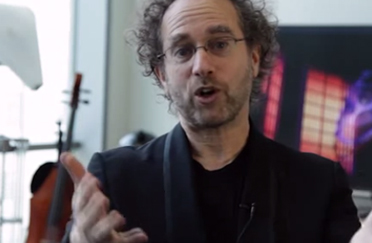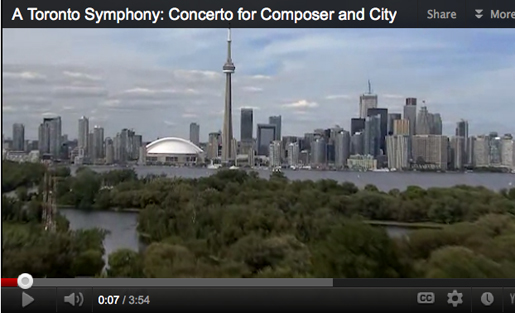“Over the coming months, I am inviting you — the citizens of Toronto — to collaborate with me to compose a new symphony which will be premiered by the Toronto Symphony Orchestra … Some of the music will be by you, some by me, and some shaped by us together. My hope is that we will create something that neither you nor I could have done without each other, and that will be surprising, stimulating, and beautiful, a musical portrait about — and by — Toronto.”
— Tod Machover
Tod Machover knows how to collaborate. A composer, inventor and educator at the MIT Media Lab who was nominated for the 2012 Pulitzer Prize for Music, his innovative approach to collaboration with A Toronto Symphony offers lessons in artistic collaboration as well as lessons for collaborators in all sectors — journalism included. We recently spoke by phone.
Collaborating with a City

In addition to composing his own music, Machover is passionate about making music central to people’s lives — and many of the technologies he’s created do just that, from the technology behind Guitar Hero to Hyperscore, which lets anyone compose music using visual tools.
When the Toronto Symphony asked him to curate an upcoming festival for them, and to explore the theme of the future of orchestras, Machover saw an opportunity to bring his passions together. “Is there a way to make the kind of music I really want to make,” he asked himself, “and open up to the public?”
Machover was also interested in creating dialogue between musicians and consumers of music, including the growing number of consumers who make their own musical mash-ups. “There’s really no dialogue between the artists putting out commercial stuff,” he said, and the people who are riffing off of it. At the same time, he observed, everyone uses social media — “you can’t be an artist without using it” — but “a lot of social media actually creates more of a gap” between artists and audiences. “You become more known, but you aren’t more accessible.” With the Toronto Symphony, Machover saw an opportunity to experiment with a new model of a collaboration with the general public.
“Could I invite people into the creative process in a way that would be exciting to all of us?,” he wondered.
Hence, the collaborative Toronto Symphony project was born, with Machover formally inviting every resident of the city to participate, with a blog post (quoted at the beginning of this article) and video (see below). His approach offers inspiration for any organization looking to involve citizens in its work in meaningful, rather than token, ways.
From Solo Artist to Collaboration Leader
When he first started out, Machover never would have imagined that collaboration would be such a central theme of his career. In fact, back in college, part of what appealed to him about becoming a composer was the promise of solitary work. So what happened? In a word: technology.
“The things that excite me don’t usually map directly to how music’s made, how instruments exist, how people usually rehearse,” Machover told me. “There’s usually something I need to construct to make the music I want to. This is why I was attracted to technology. Creatively, I was drawn to this expansion of the way I make music every time I think of a piece, and that naturally brought me into environments where I had partners.”
He credits MIT for providing an open, creative environment where it’s possible for people with diverse backgrounds to work together on a common problem or idea. “I love building groups of people who are from very different backgrounds,” he said. “When they work right, it always feels like something happens that I didn’t exactly predict.”
Designing Collaboration
For the Toronto Symphony project, Machover designed a series of very specific challenges to spur residents’ participation, which he’s released — and continues to release (the next one’s coming December 6) — through the project’s website. For example, the first challenge he sent out “was a challenge to listen to the city,” inviting residents to notice sounds that struck them as typical of Toronto, or that they particularly liked or didn’t like; then, they could either record these sounds and submit them, or simply submit descriptions of the sounds, and Machover’s team would do the recording. In addition, Machover scheduled sessions in which residents could join him on a listening tour of the city. He compiled a library of all the sounds he collected (“there was a huge number of submissions,” he said), which he’s woven into a series of sound collages. He also recorded people saying things about Toronto in various languages — more creative fodder.
In addition to issuing these general challenges, Machover has designed opportunities for collaboration that are targeted to individual groups and constituencies within the city. For example, when he learned about an indie rock festival in Toronto over the summer, he saw an opportunity to get that part of the city’s music community involved in the symphony project. He asked himself, “What would be the best way to catch their imaginations?” In the end, he invited each band to contribute a short piece of music (five seconds max — “one second is best”) that was a kind of immediate signature for their sound, and that represented something that could only be done in Toronto — whatever that meant to them. About three-fourths of the bands participated, and Machover plans to weave their sounds into the final composition.
When it came to the city’s Youth Orchestra, Machover arranged for an in-person collaborative session. He played for the students a collection of recorded sounds he’d gathered earlier in the project; he then asked them to recreate the sounds of each recording using instruments. For example, after they listened to a recording made at one of the city’s beaches, he asked, “What instruments can we use to recreate the sound of the ocean?” Students spent only about 10-15 minutes on each recording. Like the indie bands’ signature sounds, the fruits of these sessions will be woven into the project’s final composition.
Yours, Mine and Ours
Machover clearly delights in the surprises of collaboration, however, he clarifies that whatever twists and turns a project takes, it’s essential that as an artist, he finds the final product meaningful. “The beauty and real challenge of collaboration,” he told me, “is how to coordinate one’s own passion and vision, with the ability … to involve others.”
Often, he observed, collaborations result in decisions made by committee — when this happens, everyone accepts the outcomes, but no one is excited by them. On the other hand, if the leader of a collaboration pushes too hard for his or her own vision, participants feel manipulated. Yet, collaboration leaders need to be careful not to let attention to other people’s ideas morph a project into something about which they no longer feel an authentic spark — when they do, they end up simply managing the project, rather than infusing it with their unique vision or personality.
It’s a difficult balancing act, and one that Machover may have had in mind when he said in the video introducing the Toronto Symphony project that he was looking for a mixture of material: “yours, mine and ours.”
“Yours” is material created by the city’s residents; “mine,” clearly, is music that Machover himself composes. “Ours” is what they compose together. The combination of these three types of authorship promises to create something very rich, which strikes the balance Machover seeks between individual vision and collective creativity.
In an article in The Guardian, Machover emphasizes that the Toronto Symphony is not crowdsourcing — it’s collaboration. “Crowdsourcing is a one-way ask for something very specific,” he says, whereas “collaboration is something that goes back and forth, and turns into something truly open.”
What’s Next
On December 6, Machover will issue his latest challenge, simultaneously debuting a new software tool called Mediascore, which lets “different collaborators talk to each other and shape sections (of a musical composition) without necessarily knowing how to write music” — composing, for example, by drawing lines and choosing colors.
And then, who knows — maybe replicating the Toronto Symphony project in other cities. “We’ve been inventing as we go,” Machover says. “The second city might be easier.”
Amanda Hirsch is the editor of Collaboration Central. She is also a writer, performer and social media strategist who lives in Brooklyn, N.Y. The former editorial director of PBS.org, she blogs at amandahirsch.com and spends way too much time on Twitter. Her latest project, Having a Ball Having it All, explores what it really means for women to have it all.

